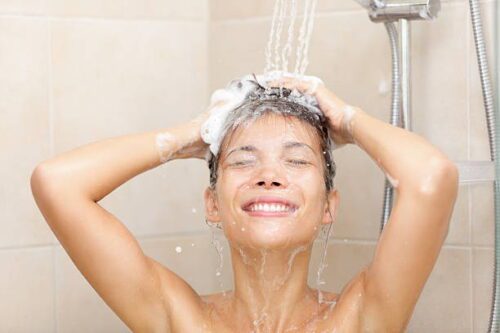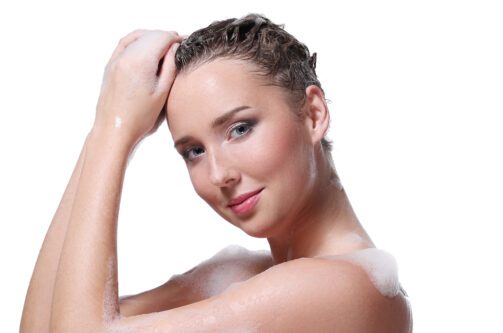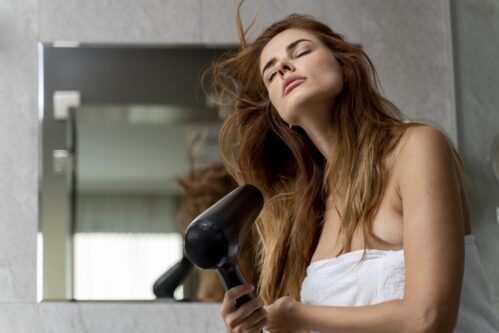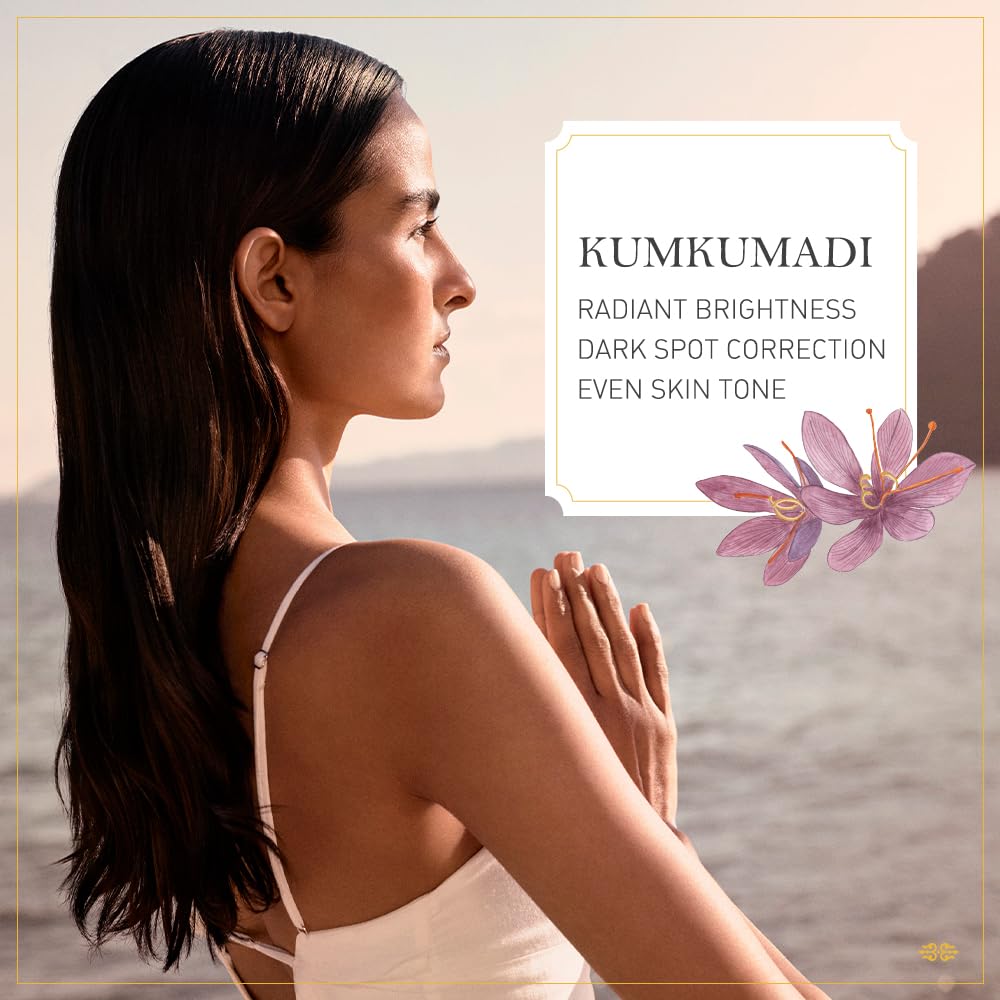Tips for shiny hair Having beautiful, shiny, and lustrous hair is a dream for many. Your hair plays a crucial role in defining your overall look and confidence. While there are numerous hair care products and treatments available in the market, achieving naturally gorgeous hair starts with adopting a healthy hair care routine. In this article, we’ll explore seven essential tips that can help you attain the shiny and lustrous locks you’ve always desired.
1. Stay Hydrated for Hair Hydration
- In the quest for luscious and healthy hair, we often overlook one of the simplest yet most effective solutions: staying hydrated. Just as proper hydration is vital for our overall well-being, it also plays a crucial role in maintaining the health and vitality of our hair.
- In this comprehensive guide, we will unravel the importance of hydration for your hair and provide practical tips to keep your locks nourished and radiant.
The Hair-Hydration Connection
- Before delving into the ways to keep your hair hydrated, let’s understand the connection between hydration and hair health. Our hair shafts are made up of a protein called keratin, which contains water molecules. When your hair lacks adequate moisture, it can become brittle, prone to breakage, and lose its natural shine.
Signs of Dehydrated Hair
- Identifying the signs of dehydrated hair is the first step in addressing the issue effectively. Look out for the following indicators:
- Dryness: If your hair feels dry to the touch and lacks its usual softness, it’s a clear sign that it needs more moisture.
- Brittleness: Dehydrated hair is often brittle and prone to splitting and breakage, even with minimal stress.
- Dullness: Lack of hydration can lead to a lackluster appearance, making your hair look dull and lifeless.
- Increased Frizz: Dehydrated hair tends to absorb moisture from the air, causing it to become frizzy and unruly.
Hydration Tips for Healthy Hair-:
- Now that we’ve established the importance of hair hydration, let’s explore practical ways to ensure your locks stay nourished and vibrant:
1. Drink Plenty of Water
- The foundation of hair hydration is internal hydration. Drinking an adequate amount of water daily not only benefits your overall health but also directly impacts the moisture levels of your hair. Aim for at least 8 glasses of water a day.
2. Use a Hydrating Shampoo and Conditioner
- Choose hair care products specifically formulated to provide hydration. Look for shampoos and conditioners that contain ingredients like glycerin, aloe vera, and coconut oil, which help lock in moisture.
3. Limit Heat Styling
- Excessive use of heat styling tools can strip your hair of its natural moisture. If you must use heat, always apply a heat protectant spray and use the lowest heat setting possible.
4. Weekly Deep Conditioning
- Incorporate a deep conditioning treatment into your weekly routine. This helps infuse your hair with moisture and repair any damage caused by environmental factors.
5. Cold Water Rinse
- After conditioning your hair, rinse it with cold water. Cold water helps seal the hair cuticles, locking in moisture and adding shine.
6. Protect Your Hair from the Sun
- Prolonged sun exposure can dehydrate your hair. Whenever you’re out in the sun, consider wearing a wide-brimmed hat or using a hair product with built-in UV protection.
7. Avoid Overwashing
- Washing your hair too frequently can strip away its natural oils, leading to dehydration. Aim to wash your hair every 2-3 days or as needed.
8. Silk Pillowcases
- Sleeping on a silk pillowcase reduces friction and prevents moisture loss from your hair as you sleep.
2. Nourish from Within with a Balanced Diet
- When it comes to achieving radiant and healthy hair, the significance of a balanced diet often gets overlooked. We tend to focus solely on external hair care routines and products, forgetting that what we put into our bodies also plays a pivotal role in determining the quality of our hair.
- In this comprehensive guide, we will delve into the transformative effects of nourishing your hair from within through a well-rounded and nutrient-rich diet.
Understanding the Hair-Nutrition Connection
- Before we dive into the specifics of a balanced diet for healthy hair, it’s important to understand the intricate relationship between the nutrients we consume and the state of our hair. Our hair follicles require a variety of vitamins, minerals, and proteins to grow, remain strong, and maintain their luster.
- Insufficient intake of these essential nutrients can lead to hair issues such as thinning, breakage, and dullness.
Key Nutrients for Hair Health
- To ensure your hair gets the nourishment it needs, incorporate the following key nutrients into your diet:
1. Protein
- Hair is primarily composed of a protein called keratin. Including sufficient protein in your diet is crucial for maintaining hair strength and promoting growth. Sources of protein include lean meats, poultry, fish, eggs, dairy products, legumes, and nuts.
2. Omega-3 Fatty Acids
- Omega-3 fatty acids contribute to scalp health by reducing inflammation and promoting blood circulation. Foods rich in omega-3s include fatty fish (like salmon and mackerel), flaxseeds, chia seeds, and walnuts.
3. Biotin
- Biotin, also known as vitamin H, is a water-soluble B vitamin that is essential for hair growth and overall hair health. You can find biotin in foods such as eggs, nuts, seeds, sweet potatoes, and leafy greens.
4. Vitamins A and C
- Vitamin A helps produce sebum, the natural oil that keeps your scalp moisturized, while vitamin C aids in collagen production, which strengthens hair shafts. Incorporate foods rich in these vitamins, such as carrots, sweet potatoes, oranges, and bell peppers.
5. Iron
- Iron is vital for carrying oxygen to hair follicles and promoting hair growth. Include iron-rich foods like lean red meats, poultry, beans, lentils, spinach, and fortified cereals.
6. Zinc
- Zinc plays a role in hair tissue growth and repair. Foods like oysters, beef, pumpkin seeds, and whole grains are excellent sources of zinc.
3. Choose the Right Hair Care Products
- When it comes to maintaining lustrous, healthy hair, the importance of choosing the right hair care products cannot be overstated.
- The market is flooded with a plethora of options, each promising miraculous result, making the selection process seem overwhelming. Fear not, for we are here to guide you through the maze of choices, helping you make informed decisions that will elevate your hair care routine to a whole new level.
Understanding Your Hair Type-:
- The very first step in choosing the right hair care products is to understand your unique hair type. Hair varies widely from person to person, and what works for one might not necessarily work for another. Different hair types require different formulations to achieve the best results. Here’s a breakdown of the most common hair types and their characteristics:
1. Straight Hair
- Straight hair tends to be naturally glossy but can also become oily quickly. Look for lightweight, volumizing shampoos and conditioners that won’t weigh down your locks.
2. Wavy Hair
- Wavy hair strikes a balance between straight and curly. Opt for products that enhance your natural waves while keeping frizz under control. Moisturizing shampoos and curl-defining creams are your best friends.
3. Curly Hair
- Curly hair craves moisture and definition. Choose sulfate-free, hydrating products that support your curls’ structure and minimize frizz. Creamy leave-in conditioners and curl-enhancing gels are must-haves.
4. Coily Hair
- Coily hair, often tightly curled or coiled, requires intense moisture and careful handling. Invest in ultra-moisturizing products, such as deep conditioning masks and natural oils, to maintain its health and vibrancy.
Decoding Hair Care Product Labels
- Now that you have a grasp of your hair type, it’s time to decode those product labels. Understanding the terminology on the bottles can help you identify the right products for your specific needs. Here are some key terms to look out for:
1. Sulfate-Free
- Sulfates are aggressive cleansers that can strip your hair of its natural oils. Opt for sulfate-free shampoos to maintain your hair’s moisture balance and prevent excessive dryness.
2. Paraben-Free
- Parabens are preservatives that have raised concerns about their potential health effects. Paraben-free products are a safer option for your hair and overall well-being.
3. pH-Balanced
- A pH-balanced product helps maintain your hair’s natural acidity, preventing issues like dryness and breakage. Look for this term to ensure your hair remains healthy and resilient.
4. Protein-Enriched
- For those with damaged or weakened hair, protein-enriched products can work wonders. They help strengthen and repair your hair’s structure, promoting overall health.
4. Avoid Overwashing Your Hair
- In the pursuit of healthy and beautiful hair, the concept of overwashing often goes overlooked. We all desire hair that looks fresh and clean, but excessive washing can do more harm than good. In this comprehensive guide, we’ll delve into the reasons why you should avoid overwashing your hair and provide valuable tips to strike the perfect balance between cleanliness and hair health.
Understanding the Impact of Overwashing
- To comprehend the significance of avoiding overwashing, it’s essential to grasp how our hair functions. Each strand of hair is surrounded by a protective layer of natural oils, known as sebum. Sebum serves as a natural conditioner, keeping our hair soft, supple, and protected from environmental stressors. However, overwashing can strip away these oils, leaving our hair vulnerable and prone to a range of issues.
Signs of Overwashed Hair
- Recognizing the signs of overwashed hair is crucial in adjusting your hair care routine:
- Dryness and Frizz: Overwashed hair often becomes dry, brittle, and frizzy due to the lack of natural oils that provide moisture.
- Excess Oil Production: Paradoxically, overwashing can lead to an overproduction of oil as your scalp tries to compensate for the lost sebum, resulting in an oily scalp and greasy roots.
- Irritation and Sensitivity: Frequent washing can cause scalp irritation and sensitivity, leading to discomfort and itchiness.
- Color Fading: If you color your hair, overwashing can cause the color to fade more quickly, diminishing the vibrancy of your hair.
Finding the Right Washing Frequency
- Achieving the right balance between cleanliness and maintaining your hair’s health involves finding the optimal washing frequency. Here are some general guidelines to consider:
1. Hair Type
- Different hair types have different needs. While fine hair may require more frequent washing due to its tendency to become oily quickly, coarse or curly hair can go longer between washes.
2. Lifestyle
- Consider your daily activities. If you engage in activities that make your hair sweaty or dusty, you may need to wash it more frequently. On the other hand, if you have a sedentary lifestyle, you might be able to wash less often.
3. Experimentation
- Finding the perfect washing frequency might require some trial and error. Start by extending the time between washes and observe how your hair responds. You might be surprised by how your hair’s natural beauty shines through.
Tips for Caring for Unwashed Hair
- Maintaining your hair’s health between washes is just as crucial as finding the right washing frequency. Here are some tips to ensure your hair looks its best even on non-wash days:
1. Dry Shampoo
- Dry shampoo is a lifesaver for absorbing excess oil and refreshing your hair between washes. Use it on your roots to add volume and extend the time between washes.
2. Brushing
- Regularly brushing your hair helps distribute the natural oils from your scalp to the rest of your hair, promoting overall shine and softness.
3. Protective Hairstyles
- Experiment with updos, braids, or buns to keep your hair looking stylish and protected while avoiding the need for frequent washing.
5. Use Cold Water for the Final Rinse
- When it comes to hair care, the final rinse is often underestimated. Many of us tend to rinse our hair with warm water without realizing that using cold water for the final rinse can have a transformative impact on the health and appearance of our locks.
- In this comprehensive guide, we will uncover the benefits of using cold water for the final rinse and explain how this simple step can lead to shinier, more vibrant hair.
The Science Behind Cold Water Rinses-:
- Before we explore the advantages of using cold water, it’s important to understand the science behind this hair care technique. Warm water opens the hair cuticles, which are the outermost protective layer of each strand.
- While this is beneficial for thorough cleansing and conditioning, it can also lead to moisture loss and frizz. Cold water, on the other hand, helps seal these cuticles, locking in the moisture and nutrients from your hair products.
Benefits of Cold Water Rinses-:
- Using cold water for the final rinse offers a range of benefits that contribute to the overall health and appearance of your hair:
1. Seals Cuticles-
- Cold water causes the hair cuticles to contract and lie flat. This results in smoother, shinier hair that is less prone to frizz and breakage.
2. Adds Shine
- As the cuticles seal, the hair’s surface becomes more reflective, enhancing its natural shine and luster.
3. Retains Moisture
- By sealing the cuticles, cold water helps lock in the moisture from your conditioner and treatments, keeping your hair well-hydrated and soft.
4. Reduces Frizz
- Closed cuticles prevent humidity from entering the hair shaft, reducing frizz and keeping your hairstyle intact.
5. Enhances Color
- For those with color-treated hair, cold water rinses can help preserve the vibrancy and longevity of your hair color by preventing color molecules from escaping.
6. Promotes Scalp Health
- Cold water rinses stimulate blood circulation to the scalp, promoting better nutrient delivery to the hair follicles and supporting overall hair health.
Incorporating Cold Water Rinses into Your Routine
- Now that you’re aware of the benefits, let’s explore how to incorporate cold water rinses into your hair care routine:
1. Shampoo and Condition
- Begin by shampooing and conditioning your hair as usual. Use warm water for cleansing and conditioning steps.
2. Final Rinse with Cold Water
- Once you’ve completed your hair care routine, adjust the water temperature to cold or lukewarm for the final rinse. Gently pour the cold water over your hair, making sure to cover all areas.
3. Embrace the Chill
- While the sensation of cold water might be a bit startling at first, the benefits far outweigh the momentary discomfort. Embrace the coolness and envision the shine and vitality it’s bringing to your hair.
4. Towel Dry
- After the cold water rinse, gently towel dry your hair by patting it with a soft towel. Avoid rubbing vigorously, as wet hair is more susceptible to damage.
5. Style as Desired
- Proceed with your usual styling routine. You’ll likely notice that your hair feels smoother, looks shinier, and is easier to manage.
6. Protect Your Hair from Heat Styling
- In the pursuit of glamorous hair, it’s easy to fall into the trap of excessive heat styling. While those sleek, bouncy curls and smooth strands might look stunning, the long-term effects of heat on your hair can be detrimental. In this comprehensive guide, we’ll explore the art of safeguarding your hair from the damaging impact of heat styling, allowing you to embrace both style and health.
Understanding the Heat Styling Dilemma-:
- Heat styling tools like flat irons, curling wands, and blow dryers offer instantaneous transformations, but they can also lead to hair problems over time:
- Dehydration: High temperatures can strip your hair of its natural moisture, leading to dryness and brittleness.
- Breakage and Split Ends: Prolonged exposure to heat weakens hair fibers, causing breakage and the dreaded split ends.
- Color Fading: Heat styling can accelerate color fading, causing your vibrant hue to turn lackluster.
Steps to Shield Your Hair from Heat Damage
- Protecting your hair from heat styling doesn’t mean sacrificing your desired look. Here’s how to strike the perfect balance between style and hair health:
1. Apply a Heat Protectant
- Before subjecting your hair to heat, always apply a heat-protectant spray or serum. This invisible shield creates a barrier between your hair and the heat, minimizing damage.
2. Opt for Lower Temperatures
- Most heat styling tools come with adjustable temperature settings. Choose the lowest temperature that achieves your desired style. High heat isn’t always necessary and can lead to unnecessary harm.
3. Limit Frequency
- Avoid using heat-styling tools every day. Allow your hair to rest between sessions to prevent cumulative damage. Opt for heat-free styles on non-styling days.
4. Air Dry Whenever Possible
- Let your hair air dry whenever feasible. This reduces exposure to heat and preserves your hair’s natural moisture.
5. Prioritize Quality Tools
- Invest in high-quality heat styling tools that distribute heat evenly. Ceramic and tourmaline coatings are excellent options, as they reduce hot spots and minimize damage.
6. Use Heat Styling Accessories
- Consider using heat styling accessories like diffusers and nozzle attachments that help distribute heat evenly and protect your hair from direct exposure.
7. Pre-Treat Your Hair
- Prep your hair with a hydrating conditioner before heat styling. This adds a layer of protection and keeps your locks moisturized.
8. Section Your Hair
- When using heat styling tools, work in small sections. This ensures that you style each section efficiently without exposing your hair to excessive heat.
Post-Heat Care for Healthy Hair
- After heat styling, pamper your hair to minimize the impact:
- Cool Down: Allow your hair to cool before touching or styling it further. Heat can linger, causing additional damage.
- Apply a Serum: Run a nourishing serum through the ends of your hair to lock in moisture and enhance shine.
- Weekly Treatments: Incorporate weekly deep conditioning treatments to repair any heat-induced damage and maintain your hair’s health.
7. Regular Trims for Healthy Ends
- The journey to beautiful and healthy hair doesn’t solely rely on elaborate routines or expensive products. One of the most fundamental yet often overlooked steps is getting regular trims. While it might seem counterintuitive to cut your hair for growth, regular trims play a crucial role in maintaining vibrant, strong locks.
- In this comprehensive guide, we’ll dive into the importance of regular trims for healthy hair ends and how they contribute to your overall hair care journey.
Understanding the Hair Growth Cycle-:
- To understand the significance of regular trims, it’s important to grasp the hair growth cycle. Hair grows in cycles of anagen (growth), catagen (transition), and telogen (rest). During the anagen phase, your hair grows actively from the follicle. Over time, however, the ends of your hair can become damaged due to factors like styling, environmental stress, and friction.
The Benefits of Regular Trims-:
- Getting your hair trimmed regularly, even if you’re aiming for length, offers a range of benefits:
1. Prevents Split Ends
- Split ends occur when the protective outer layer of the hair cuticle is damaged and begins to fray. Regular trims prevent split ends from traveling up the hair shaft, preserving your hair’s overall health.
2. Encourages Growth
- Contrary to popular belief, regular trims can promote hair growth. By removing damaged ends, your hair can grow more evenly and healthily.
3. Maintains Shape and Style
- If you have a specific hairstyle or shape, regular trims help maintain the integrity of your style, preventing it from looking uneven or unruly.
4. Reduces Breakage
- Trimming damaged ends reduces the risk of breakage. Healthy ends are less likely to snap off, allowing you to retain length and thickness.
5. Enhances Hair Appearance
- Trimming your hair regularly contributes to a neater appearance. Your hair looks fresher, shinier, and more vibrant after a trim.
6. Supports Scalp Health
- Regular trims also promote scalp health. Removing split ends reduces the burden on the scalp and prevents potential scalp issues.
Frequency of Trims
- The frequency of trims varies based on your hair’s needs. As a general guideline:
- Fine Hair: Every 6-8 weeks
- Medium to Coarse Hair: Every 8-12 weeks
- Curly Hair: Every 10-12 weeks
- However, listen to your hair – if you notice excessive split ends or damage, consider scheduling a trim sooner.
Post-Trim Care
- After getting a trim, show your hair some extra love:
- Hydrate: Use a moisturizing conditioner to keep your hair hydrated and prevent dryness.
- Protect: Apply a heat protectant before using styling tools to shield your newly trimmed ends from damage.
- Nourish: Incorporate a hair mask or deep conditioning treatment to nourish and rejuvenate your hair after the trim.
Conclusion-:
Achieving shiny and lustrous locks requires a combination of healthy habits, proper care, and the right products. By staying hydrated, maintaining a balanced diet, using suitable hair care products, and following these tips, you can enhance the natural beauty of your hair. Remember, consistency is key to seeing lasting results.











